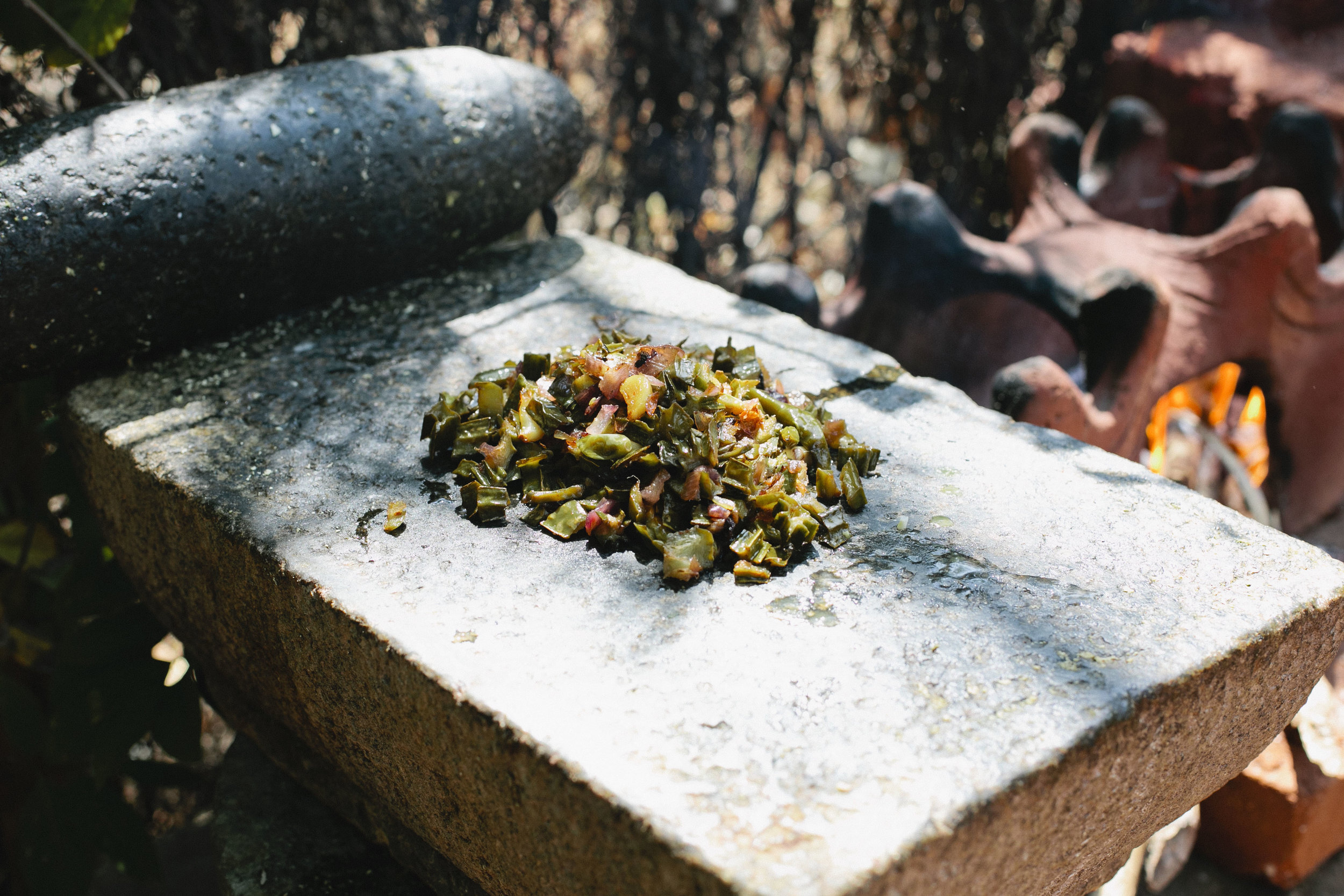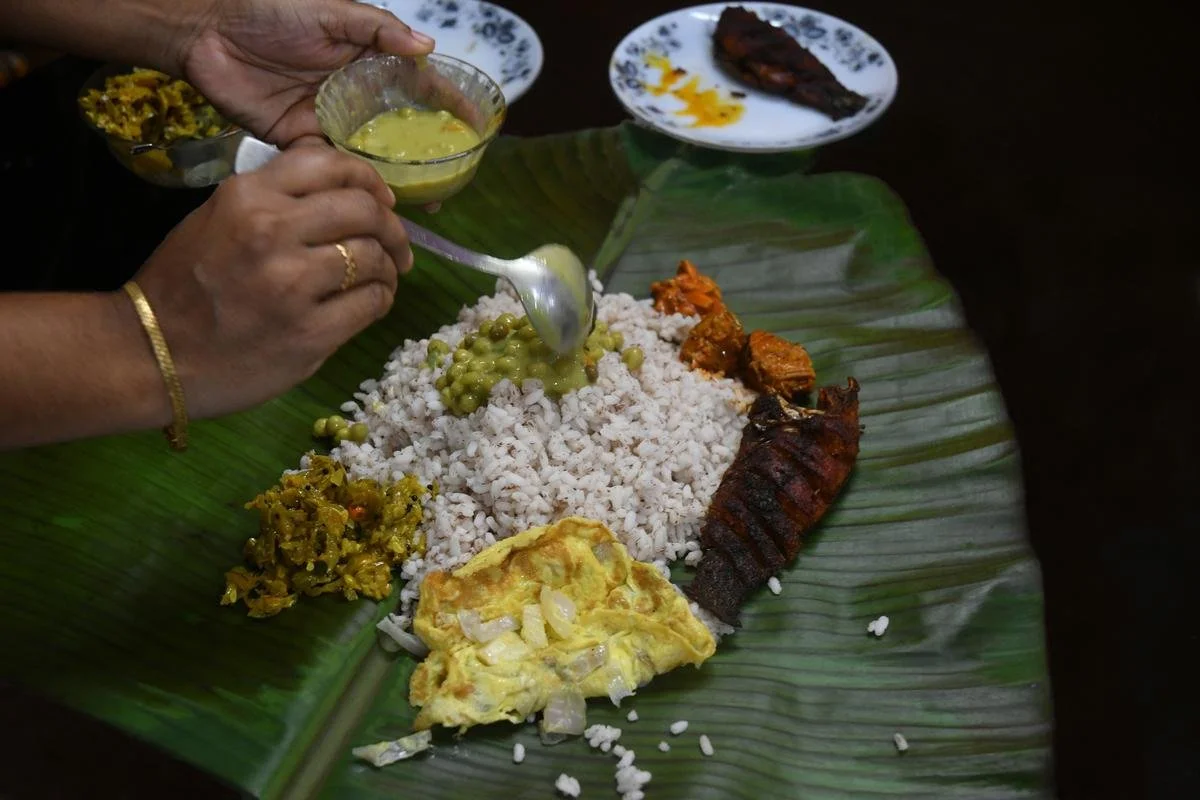Bata & the Underground Cuisine of the Shil Pata

Sumana Roy writes about bata, an East Bengali manner of cooking that comes from a culture of frugality and subsistence, but also intimacy.
I was looking for a shorthand to name this file when I began writing. I settled on a four-letter word: Bata. It is possible that it might be misunderstood to be an essay about shoes. But I’d like to stick to the sound in which this food comes to me. Bata. Ground to a paste on a shil pata, a large flat piece of stone on which a shil nora — a cylindrical piece of stone — beats, crushes, drags, and beats, crushes, drags again, until everything that was once solid loses its form. The ‘bata’ is an open secret in Bengali kitchens. Like anyone writing in the English language, looking for a comparative, I turn to one of my favourite kinds of bata outside the Indian kitchen: the pesto. I suspect that the word comes from ‘pestle’, on which something is ground to a ‘paste’. Bata — the genre of cooking — too, derives its name from the verb: bata, grinding to a paste, becoming a noun.
Bata is mostly – and, I’m tempted to say, uniquely — an East Bengali manner of cooking, a culture that learnt not to throw away anything. In spite of its older history of abundance, made possible by rivers ferrying fertile alluvial soil, the new history of the Bangal — the East Bengali — is one of deprivation, engineered by political forces. The Partition and the Bengal famine, both of which changed the character of Bangal life, led to inventive ways of checking hunger in large families. When I first ate rice with a greenish paste from Jharna-didi’s lunch box two decades ago, it was history that I held inside my mouth. A hair-dresser’s assistant in a salon in the suburbs of Siliguri, a small town in northern Bengal, Jharna-didi’s parents had walked from Bangladesh to India many decades ago. They lost a child on the way, and finding no employment, they were soon eating whatever they could find. Most of it was leaves and stems. A slab of stone on the bank of the Balasan river, and then another round stone — a makeshift shil pata was conjured into being. Jharna-didi’s mother began making pastes of all kinds of edible leaves that she could forage from the tea estate where her husband found temporary employment. As the family grew, and Jharna-didi followed an older brother into their world, her mother would scavenge the trash heap outside the tea estate manager’s bungalow. There was an abundance of vegetable peel — potato, pointed gourd, bottle gourd, watermelon rind, melons and apple, cucumber and papaya. Most of these she committed to her shil pata, grinding them to a paste with nigella seeds, cloves of garlic, and green chillies. I discovered, from the flavours of the food in Jharna-didi’s lunch box, that the bata was a bit too salty for my taste. Jharna-didi explained this — there was little else to eat; so rice would be eaten with only bata, and the high proportion of salt was meant to season the large quantities of rice that were consumed.
Since then I have tasted many kinds of bata from Jharna-didi’s lunch box: the bata of greens cooked as saag, peels of vegetables, tomatoes roasted on an open fire and ground with garlic, chillies and salt; but most surprising of them, potato peels, sandy to the eyes, turned into something delectable, and leftover rotis ground to a paste with peanuts, garlic and red chillies. Many of these are not eaten raw, but cooked in a little oil to get rid of moisture, and the pungency of uncooked spices.
When Sapna-didi began cooking for us about twenty years ago, I found a partner to eat dried fish. My mother never cooked it, and the family I’d married into didn’t eat it either. She’d carry it secretively in a lunch box for me — cooked with seasonal vegetables; broad beans in winter, and jackfruit seeds in summer, the heat from the chillies exploding into the air and into our nostrils as soon as she opened the box. It was a place of rest for us, like the afternoon is to the day. We often ate this on the terrace, our little secret, lest the members of my new family found out. It was on one such afternoon that I ate shidol for the first time: fermented fish ground to a paste.
The next day she brought something new: dried Bombay duck roasted lightly on an open fire, then ground to a paste with garlic and an army of chillies. My tongue and lips and gullet needed the Fire Brigade, but I was a survivor, and, like most such survivors, I was soon an addict.
Born to a landed family in Bangladesh, Sapna-didi was raised on fresh produce, from the land and water. Unable to feed her family with the food of her childhood in this new town she lived in, she often tried to reproduce a version of those flavours with the bata. My favourite among these experiments — ‘trials’, in both senses of the word, would perhaps be more accurate — is what she does with the heads and shells of prawns and shrimps. Instead of discarding them, a few days after we’ve had shrimp — portions of which I quietly smuggle into her bag for her family — she will surprise me with shrimp head-and-shell bata. We eat it together, usually on the balcony, with steaming hot rice, and we eat it silently — both under a spell, any sound beside the saliva in our mouth superfluous . Like pickle, even a tiny bit is sufficient for a meal. She carries a portion back for her family at home — the price of shrimp and prawn in our town, far away from the sea, is high: the sense of prawns will do. As we lick our fingers, she will spend a few sentences pitying the wealthy — how they discard portions of fish and vegetables where the ‘ashol swad’, the real taste, actually lives.
New things enter this space and are welcomed with gratitude — by consigning them to the shil pata, where they are ground for various kinds of consistency. None of these are smooth pastes — that is the handiwork of the electrical mixer-grinder. Like all machines, the mixer-grinder treats everything and everyone with a kind of equality that does them injustice: everything is punched, squashed and pulverised into the same kind of sandalwood-paste texture. The shil pata is more respectful of difference — it treats dried fish differently from greens. So, even though it is demanding, we sit on our haunches and move to the rhythm of grinding, the vegetable peel or greens, pushed from the back of the shil pata to its arched front, and then dragged back again, a process of repetition not completely unlike singing a raag, where the voice goes out, explores, and then returns to the sama, its home. Unlike the machine, the eye tells the hand to stop. And the bata is dragged with three fingers on to a bowl, trailing marks on the flat stone until not a pinch remains. That would be unimaginable — the loss of even a drop of this paste, in a household struggling to feed its many members.
The bata comes from a culture of frugality and subsistence, but also of intimacy, one that trusts the hands and fingers of people outside the perimeter of the family. I wonder whether this is also responsible for bata being denied a place at Bengali wedding feasts, picnic menus, or even get-togethers. It is food that is dependent on touch, and a culture where touch — and untouchability — keeps a caste system and its ideas of purity intact, the bata (as well as the makha, a mash, given taste and character by the individuality of the cook’s hands) remains an underground cuisine. In spite of Bengali cuisine being one where food is eaten with one’s fingers, it is possible to avoid the touch of the cook or the person serving meals with serving spoons and ladles. Bata, made on a shil pata, where human fingers bring everything together, has thus been censored — it has been unable to jump past the caste and class barrier. In the middle-class Bengali household, where cooking is now mostly done by workers from lower income groups, it is unlikely that a genre such as the bata will be able to go past the family’s hygiene (or “purity”) censorship.
The oeuvre keeps adding to itself. During the lockdown, when we were short of vegetables and essentials, I began to think of things I could turn into a bata. Sapna-didi suggested raw banana peel — she was at home, and we often spoke on the phone. I went to our backyard with a machete and brought three raw bananas and a couple of banana leaves with me to the kitchen. The banana peel was soon in my hand, and, with it, garlic and green chillies. I boiled it for a little while and watched its resistance drain off into blackish water. Soon I was pounding the three on the shil pata and, once the paste was done, frying it with a little oil in a wok. We ate it with rice for lunch — I did not tell the family what it was they were eating. When I carried some for my sister-in-law, she told me it reminded her of the time she was breastfeeding, when she’d eat a bata of nigella seeds, garlic, a hint of chilli and salt, fried in a little oil. It was folk wisdom, to help the lactating mother. Something or the other jumps onto my shil pata now: peanuts, turned into a bata with a roasted tomato, garlic and chillies; even peanut butter, or mango and apricot jam, finding a new afterlife.
A cuisine of the leftover, of a people who believed that nothing must be wasted, of things rejected by the wealthy as unnecessary; the taste and sophistication of the bata is an achievement of imagination, of people who live with less. As I write this, I think of the taro that I will peel, then cut and grind into a bata with coconut, mustard seeds, green chillies and salt, tomorrow. A few drops of mustard oil on its mottled white skin, before it takes over my plate… and my day. Sapna-didi is waiting for the first young leaves of cauliflower and cabbage that winter will bring, and later, though we don’t say it to each other, for someone from Darjeeling to bring us a handful of rhododendron flowers that we will turn into a red bata. It will drip off the shoulders of the shil pata and I will run towards it and say to Sapna-didi, ‘Theretherethere a drop of red falling off don’t-let-it-fall theretherethere’.
It will be spring, and we will eat it like things can only be eaten in spring — without accompaniment, just as itself.
Sumana Roy is the author of How I became a Tree, a work of nonfiction, Missing: A Novel, Out of Syllabus: Poems and My Mother’s Lover and Other Stories, a collection of short stories.
ALSO ON THE GOYA JOURNAL










